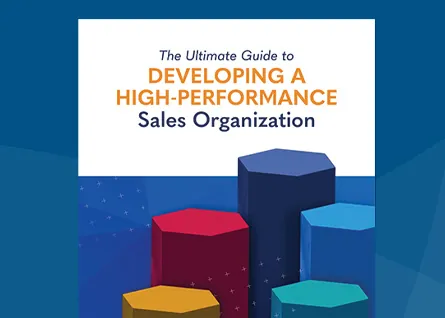A Comprehensive Guide to Creating a Winning Sales Strategy

In sports, teams must create their identity. This is many disparate personalities coming together as one. Central to this is a strategy for how you will play. Will you be a fast-paced, run-and-gun offensive juggernaut? Or will you establish a hard-nosed, grind-it-out running attack? Perhaps, you’ll be defensive-minded and intimidate your opponent, cause turnovers, and force steals.
As sales pros, you might not steamroll, bully, or otherwise menace clients. However, a successful strategy is still key. It’s a defined methodology of goals, decisions, practices, and actions for how reps meet needs and achieve objectives. It is a guide for building processes and positioning products to close more deals. Here are several tips to develop a winning sales strategy:
Define Goals
Of course, all sales organizations want to sell more. However, as a strategy, this is vague. It’s akin to a sports team wanting to win games. That might be the desired result, but the devil is in the details. Better to address the specific goals to achieve the result.
As reps have quotas, organizations have short- and long-range plans. These need to be measurable and time specific, such as increasing yearly revenue 25 percent. Maybe it’s boosting yearly retention 15 percent.
When leadership define these goals, they should never forget their reps. They are responsible for the day-to-day actions that reach these plateaus. Therefore, invite their input. It’s often beneficial to start small and build up slowly. This can motivate and boost confidence.
Here are some examples of defined sales goals and how to meet them:
Increase monthly revenue by X percent: A staple of all sales organizations, this KPI is essential to boosting business. In many cases, organizations will set an overall target for the team. However, it can be further scaled for individual reps, especially for teams with wide experience gaps.
Reduce monthly churn by X percent: With the time and resources needed to court new business, it’s easy to neglect established customers. However, in many cases, they are easy to please. After all, they already know you, trust you, and want what you sell. Seek new ways to help. Get creative with loyalty incentives. Leverage relationships to upsell and cross sell. Be sensitive to need, budgets, and timing. And always build value.
Increase number of monthly qualified leads by X percent: A well-stocked pipeline is essential to growth. The more leads, the greater the opportunity to close. Often, this number can improve with better time-management. This includes more effective prospecting. It can also be boosted with regular sales coaching and training.
Reduce the length of the monthly sales cycle X percent: The shorter the cycle, the quicker the close—and the more time reps can devote to new business. Of course, rates and timeframes can vary by industry and products. However, sales cycles can often be reduced with a greater emphasis on the frontend. Better qualified leads can dramatically cut the length of your sales cycle.
Value Proposition
An organization’s value proposition is a vital part of their sales strategy. It goes to the heart of who you are as a company. It’s central to your branding and differentiates you from the competition. More than products and services, it extends to your leadership and sales team. Let’s look at each aspect in more detail:
Products: Most sales organizations are defined by their products. These are what clients need and why prospects contact you. Therefore, you need products that satisfy needs, solve problems, and provide the best value. Of course, there’s much to consider, including:
R&D: A primary question is do your products meet today’s needs? Yes, people always need widgets. However, today’s widgets must be better. Are you investing in new technology to make more widgets cheaper or last longer? Can you offer more sizes, colors, uses? What is your R&D team doing to keep up?
Manufacturing: In addition to what products do, how they are made is central to value. Manufacturing investments can be costly. However, if it reduces waste and speeds a process, it’s a value. Also, it’s a selling point. Your widgets are now sleeker, stronger, and more precise. This helps sellers illustrate the value of your widgets over the competition. And today’s buyers care more about how products are made. They want to know if it is sustainable, environmentally friendly, made in a safe work environment, etc.
Marketing: Along with how they’re made, marketing is key. After all, the very definition of marketing is promoting and selling products. The heart of this has always been providing value. Your organization knows its investment in research, development, and manufacturing. Marketing explains how these make your products superior in performance and/or value.
Services: A second component of value must be service. After all, even the best products wear down, glitch out, or need renewal. When this happens, customers need sellers who stand by their products. Service value starts with who answers the call (phone, email, website FAQ), provides comfort, reassures, and fixes the problem. While the product might not be salvageable, relationships should be preserved.
With this is your service agreement and warranty. Unless you operate in a unique space, with revolutionary products, performance is often equal. That’s why the value of your service can differentiate you and help seal deals. It can also build relationships, earn trust, and win repeat business.
Thought Leadership: A third aspect of value is thought leadership. Your organization’s knowledge, experience, and expertise are values on their own. Consider the importance of name recognition in inspiring confidence. This stems from associating previous positive experiences with specific products. In the same way, thought leadership is a value differential.
Today, most thought leadership is exhibited in content creation. Think how often you have heard phrases like “Content is king.” Unfortunately, this can sound disingenuous or superficial—like the goal is to fill space with stuff. However, the right content provides great value.
While influencers flood the internet with dance video “content,” sales organizations need specific and targeted content. This includes blogs, case studies, white papers, and other marketing collateral that positions organizations as leaders. These days, content must advance with technology. Recorded interviews, videos (not dance!), webinars, and other “live” content are cost effective and grab attention. Your marketing team must work closely with your sales team. Together, they can provide specific, targeted content to reach customers in each stage of their buying process. This can inform, instruct, and illuminate key sales points to drive need and create urgency. In this way, content is a value to both buyers and sellers.
Your Team: A fourth aspect of value is your team. As the face of your organization, they are uniquely positioned to illustrate value. Being friendly, courteous, and attentive sets the stage. Being knowledgeable, helpful, and invested seals the deal. Here are tips for how sales teams provide value:
- Know your customers
- Check-in regularly
- Give your full attention
- Be trusted advisors, not order takers
Never underestimate the value of people. More than products and services, your team inspires trust. If they believe in your products, clients will follow. When reps are excited, clients invest. This is a value that cannot be quantified. But it’s central to a successful sales strategy.
Target Markets
Your target markets are vital to your sales strategy. This is identifying the customers most likely to benefit from your products and services. Knowing how they benefit makes it easy to provide. In our sports analogy, it’s studying your opponent to understand their game. If you know how they play, you know how to counter.
Of course, your customers are not the enemy. Any sales strategy that views the seller/buyer relationship as adversarial is doomed to fail. However, understanding customers lets you work with them. This is key to a successful strategy.
Customer segmentation is a big part of knowing your target market. This is the process of dividing customers into groups by common factors they share. These can include their industry, size, products, etc. Generally, these can be divided into four segments:
- Demographic: Made up of two subsets: individual and firmographic. Individual separates customers by who they are, which includes job title, department, rank, seniority, etc. Firmographic includes location, industry, number of employees, etc.
- Behavioral: This examines customers based on their behavior, such as how they interact with your products, website, brand, etc. Other factors include their online behavior, actions taken, benefits sought, user rate, and loyalty.
- Geographic: Looks at customers based on where they live and the specific conditions that might influence decisions. These include weather, terrain, local interest, wants, and cultural considerations.
- Psychographic: Segments customers by beliefs, values, lifestyles, social status, and opinions. Other considerations include psychological characteristics, such as subconscious or conscious beliefs, motivations, and priorities.
When organizations understand their customers, they can tailor their marketing and messaging to reach them where it matters. You may only sell to a handful of industries, but they are local, national, and even international. Maybe you sell generic widgets. But top sales organizations sell generic widgets to specific, individual customers. And like the best widgets, these customers come in a variety of shapes, sizes, and colors.
Channels
As we’ve seen, organizations must invest time, money, and resources into product development. Equally important, however, is product distribution, how you get products to customers.
Today, how you sell is as important as what you sell and who you sell it to. This is where sales channels enter your strategy. In our sports metaphor, channels are the types of plays teams run. In football, it can be the hammer power run or counter. In basketball, it might be a screen and role or a triangle offense.
For B2B sellers, some of the top channels include:
- Organic sales organization: An organization with its own salesforce to develop networks of customers
- Outsourcing: When an organization uses third parties to sell their goods
- E-commerce: Employing digital channels, such as websites, apps, and games
- Resellers: Outside agents who purchase your products for resale to customers
- Channels: Selling through distributors and supporting their sales efforts
Like in sports, organizations must employ different channels. In fact, research in McKinsey shows B2B buyers use as many as ten channels to interact with suppliers. Therefore, sellers must engage their customers in different ways. Plus, according to McKinsey, there’s big money in online sales. Today, 77 percent of B2B decision makers will spend $50,000 or more in an online purchase. Plus, over one-third, 35 percent, are willing to spend $500,000. When customers say e-commerce, sellers should hear ka-ching!
Of course, your sales strategy should dictate the specific channels you employ. With advances in technology, sales teams must have the skills to meet customers where and how they buy.
Align Sales Process With Buying Process
Just as a sales organization has its strategy and processes, buyers have their own. Of course, in sports, this would be adversarial. However, today’s sellers know collaboration is best. Therefore, it’s incumbent on sellers to align their process with the buyer’s process or journey.
This is mutually beneficial in multiple ways. Consider the following:
- Improve the buyer’s experience
- Collaborate on solutions
- Build value for products and services
- Speed the sales cycle
- Increase win rates
Today’s sellers know the value of being consultative and collaborative. Ideally, they should work with clients to find solutions, solve problems, and achieve win-win outcomes. To do this, they must understand the buyer’s journey.
Generally, the buyer’s journey unfolds in several stages:
- Discover
- Evaluate
- Research and Compare
- Purchase
- Adopt
- Use
- Partner
- Share
With the internet and social media, today’s buyers are better informed than ever. Buyers can get through half their buying journey or more before contacting a salesperson. Therefore, sellers must understand where buyers are in their process. This will help them ask the right questions at the right time.
For example, say a buyer has narrowed their choices to two solutions. A seller may simply pick one and emphasize its benefits. This would be shortsighted. Without understanding the bigger picture, it might not be the best choice. Plus, it could derail the sales process.
Even if a buyer is ready to deal, it may be necessary to pause. Today, Dr. Google is a fine first step for a simple illness or medical issue. However, it’s no match for a trained and competent medical professional. Similarly, a buyer’s research may not yield the best-aligned or most cost-effective solutions. Worse, in some situations, the buyer’s research may yield results that are outdated or downright incorrect.
Often, a buyer’s self-diagnoses might be more than limited. It could be an impediment. However, rather than a hindrance for sales pros, this is an opportunity. Tactfully showing the buyer your expertise is a great way to provide solutions, build relationships, and earn trust.
Performance Metrics
Today, analytics is crucial to any sports team’s strategy. Though we see results with our own eyes, that doesn’t tell the whole story. A lucky desperation shot cannot be trusted or relied upon. Instead, for future performance, it helps to know the percentages of a play or shot.
In the same way, sales organizations track their results with KPIs, key performance indicators. These can be vital in assessing where we’re succeeding or failing. They can tell us when to stick to the game plan or course correct.
Here are some essential performance indicators of a successful sales strategy:
- Revenue growth
- Revenue per client
- Profit margin
- Client retention rate
- Customer satisfaction
Within each, we can see how well our team performs, both as a collective unit and as individuals. Also, this isn’t a mere snapshot of a single game or client. Instead, it can determine the success of our overall strategy for the season (or quarter/year).
Of course, any discussion of performance metrics must include coaching and training. After all, the main goal of determining how we’re doing is to do better. Like sports coaches, sales managers should regularly review the game tapes and the analytics. They can show the team how they won or why they lost. They can also target specific deficiencies to make the individuals and the team more successful.
In this way, it can be helpful to look at coaching as the microanalysis of your organization’s performance. It’s in-house. It’s your coaches reviewing your players and plays. In contrast, sales training is the macroanalysis. It’s outside experts who can better zoom in and zoom out. They can get granular with your team’s performance and compare it against others.
Like sales reps collaborating with clients, sales coaching and training go hand in hand. They work together to ensure your coaches and players perform at optimal levels and reach their fullest potential.
All team sports are the collective effort of individuals working for a larger group and purpose. Sales organizations are no different. With this, your sales strategy is your overall philosophy and game plan. It’s what guides your players’ goals, objectives, and beliefs and ensure their processes, activities, and behaviors align.
Of course, like any team, it a collaborative effort. As sports teams have players, coaches, and GMs working together, sales teams have reps, managers, and the C-suite. With the right strategy, they can all improve their games and win more,
For more on improving your team, see our white paper, The Ultimate Guide to Developing a High-Performance Sales Organization.

- Account Planning (12)
- Awards (44)
- Client Testimonial (37)
- Personal Branding (21)
- Podcast (12)
- Research (78)
- Sales Career Development (90)
- Sales Coaching (166)
- Sales Consulting (141)
- Sales Culture (180)
- Sales Enablement (382)
- Sales Leadership (116)
- Sales Management (267)
- Sales Negotiation (14)
- Sales Prospecting (138)
- Sales Role-Playing (19)
- Sales Training (243)
- Selling Strategies (281)
- Soft Skills (78)
- Talent Management (101)
- Trusted Advisor (29)
- Virtual Selling (57)
- Webinar (13)

























